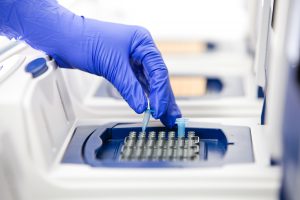
Our readers have expressed curiosity about the technology of a clinical laboratory. “Definitions by Matt” will be a continuing series to highlight your questions and provide insight into the clinical laboratory processes and terminologies.
“What is PCR (polymerase chain reaction)?”
DNA, or deoxyribonucleic acid, is present in every living cell from Humans to plants to bacteria and is used to store information. DNA is found in long chains of building blocks, called bases. Cells contain between one million to 100 billion bases connected together into a long chain. The sequence of the DNA chain, called a genome, is the primary difference between organisms.
In order for a living cell to grow and divide, the cell must first copy the DNA so each new cell gets a full copy of DNA. Cells copy DNA using an enzyme called DNA polymerase. In 1983 scientists discovered a way to use DNA polymerase to copy DNA outside of a cell in a test tube. This process, called polymerase chain reaction (PCR), has become one of the most accurate ways to determine what type of DNA is present in a sample.
PCR is a complicated reaction. In short, fragments of DNA called primers are used to guide the DNA polymerase to a specific section of the DNA chain to copy it. The primers and DNA polymerase continue to make copies of that one section of DNA until billions of copies are created. Those billions of copies are then detected by one of several methods to determine if the specific DNA sequence targeted by the primers is present in the sample. PCR is accepted as a more accurate, specific, and faster method than traditional microbiology.
Today, there are a lot of different “flavors” of PCR that are used. For example, some types of PCR are really good at efficiently copying DNA from very small starting amounts of DNA. Detecting low levels of HIV or cancer after treatment is one application of this type of PCR. Another type of PCR is good at amplifying one specific sequence from a lot of similar sequences. An example of this is determining the type of flu a person has, or if the flu has mutated. A third type of PCR can not only detect if DNA is present, but how much DNA is present. This type of PCR is useful to determine the severity of an infection and is the PCR used with MyPerioPath®.
It is important to design the PCR reaction to fit the type of analysis you’d like to perform. If PCR is designed poorly, or performed poorly, it can lead to incorrect results. PCR tests should be rigorously designed, validated, performed, and reviewed to ensure proper results. Several control reactions should be are tested alongside patient samples to ensure proper test performance. If performed correctly, PCR is a powerful tool to determine the type and amount of organisms present in a sample.
For a video depiction of the clinical laboratory process at OralDNA®Labs, click here.
If you have a comment or a specific question about the clinical lab testing process or technologies, please reach out to Matt through this blog and watch for his future posts.
For more information on how to become an OralDNA Provider – scan HERE: 
- OraRisk® Caries: Identifying Bacteria for Risk Assessment - December 28, 2018
- OraRisk® Caries: Identifying Bacteria for Risk Assessment - October 5, 2018
- Definitions By Matt: What is PCR? - November 10, 2017
